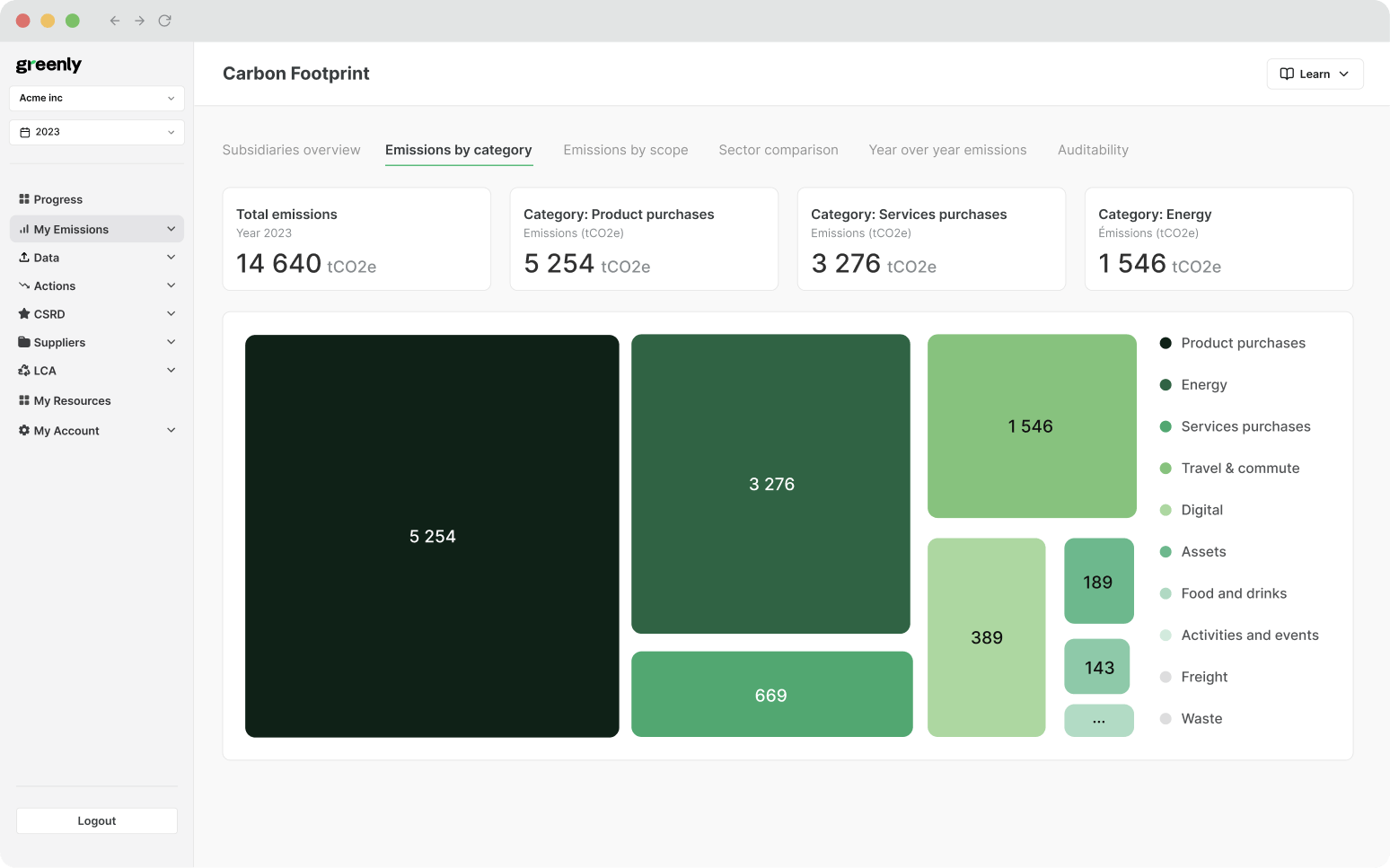
What are the 3 Pillars of Corporate Sustainability?
In this article, we'll explore what the 3 pillars of corporate responsibility are, why they're important, and how businesses can turn them into practical action.
ESG / CSR
Industries



According to recent research from Harvard Business Review, employees and customers alike now actively seek companies demonstrating measurable carbon accountability in order to reduce greenhouse gas emissions and avoid a significant carbon footprint – with comprehensive studies showing up to 71% of people seeking eco-friendly employers and customers willing to pay a 9.7% sustainability premium, even during periods of economic inflation.
In the midst of climate change, growing interest in sustainability, and the push for stronger environmental legislation – more companies are starting to take their carbon footprint seriously by making an active effort to measure and reduce their emissions.
However, tracking a corporate carbon footprint can sometimes prove more challenging than a household’s or an individual’s carbon footprint.
In this article, we'll examine the technical definition and scope of corporate carbon accounting, explain why it's important for businesses, provide an overview of scientific methodologies for accurate measurement, and present ten research-backed reasons why systematic emissions tracking can add value to your organisation.
A Corporate Carbon Footprint, often referred to as (CCF), is the overall amount of GHG emissions that are created either directly or indirectly as a result of a company’s activities.
According to the Greenhouse Gas Protocol, a CCF represents the total quantifiable environmental impact of an organisation's operations, such as the emissions generated through industrial processes, transportation, energy consumption, and waste management activities – all of which are measured, expressed, and reported in metric tons of CO₂ equivalent (CO₂e) across standardised assessment periods (typically annual reporting cycles).
Many companies working towards carbon neutrality will measure their Corporate Carbon Footprint (CCF) as a first step to better understand their current environmental impact, potential carbon reduction targets, and the most effective ways to mitigate further emissions.
Additional reasons to track a corporate carbon footprint include:
Knowing your CCF allows your company to set measurable, science-based goals for emission cuts.
Annual footprint measurements make it easier to monitor trends and see the impact of initiatives.
Publicly tracking and improving your footprint can enhance credibility and trust with stakeholders.
Carbon tracking highlights inefficiencies that, when addressed, can reduce both emissions and expenses.
Accurate CCF data ensures alignment with evolving regulations and sustainability reporting frameworks.
Understanding your impact encourages creative solutions that align business growth with climate goals.
According to an independent scientific academy based in the UK, the Royal Society, climate change poses an ongoing threat to human health and economic productivity. As a result, working to better understand the direct and indirect emissions contribute to a company’s carbon footprint is essential.
By accurately measuring emissions in terms of carbon dioxide equivalent (CO₂e) and conducting a carbon footprint calculation, businesses can implement targeted reduction strategies, the use of energy efficient technologies, and more to help mitigate future climate-related risks and impacts.
Here are some of the factors that can contribute to a company’s Corporate Carbon Footprint:
Remember, vehicle fleet emissions refer to the emissions created from burning fossil fuels in company-owned vehicles used to transport employees, customers, or materials – highlighting the newfound interest in electric vehicles for companies seeking to reduce their transportation emissions and overall corporate carbon footprint.
The summary cards will break down the contributing factors to a corporate carbon footprint:
According to the World Economic Forum, Scope 3 emissions within the supply chain typically account for over 70% of a company's total carbon footprint – which illustrates the need for sustainable procurement and improved supplier engagement to reduce a product's carbon footprint. Therefore, a sustainable supply chain is an essential component to developing a greener business, as accurate measurements of the extraction, processing, and transportation of raw materials by third-party suppliers can help to reveal all the emissions involved in production processes.
By nature, companies generate a lot of waste – whether it be from trash, recycling, or burning other waste materials created by the company. In fact, the UN Environment Program estimates that by 2050, our lack of sufficient and safe waste disposal could cost up to $640 billion USD – demonstrating the need to identify practical steps to improve waste management.
Research from the University of Twente reveals that corporate water footprints extend far beyond direct water consumption, as water usage is associated with water treatment, pumping, heating, and processing required for industrial applications and operational requirements. In fact, according to the Water Research Foundation, worldwide water usage accounts for a whopping 10% of global greenhouse gas (GHG) emissions.
Life cycle assessment methodologies established by ISO 14040 standards reveal that products generate emissions throughout their entire existence. Think about buying a bottle of sunscreen at the store, using it, and its inevitable disposal. That sunscreen bottle created emissions during every part of its life – which is why several studies emphasise the need for carbon accounting to incorporate life-cycle emissions sources ( LCA ) in order to accurately represent organisational climate impact and corporate compliance.
The Science Based Targets initiative demonstrates that seeking to effectively calculate your corporate carbon footprint requires a comprehensive measurement approach addressing all emission sources across all three scopes, meaning that a multifaceted approach to effectively measure and reduce their company’s carbon footprint will be required to address climate change, improve corporate sustainability, and avoid various climate risks.

As upcoming U.S. regulations and investor expectations are increasingly requiring transparency on emissions, measuring a corporate carbon footprint helps companies stay compliant, competitive, and credible.
The main reason for a company to measure their Corporate Carbon Footprint is that it can provide a baseline standard which extends beyond basic environmental impact assessment – as seeking to understand your organisation's activity data and carbon footprint can allow for improved sustainability goal setting and emissions reductions based on concrete carbon footprint calculations and professional guidance in carbon accounting.
The overview cards below will reveal how measuring a corporate carbon footprint can help companies:
Comparing yearly footprints helps companies measure the success of sustainability initiatives and adjust strategies as needed.
Investors, partners, and customers increasingly expect transparency on environmental impact and carbon reduction goals.
Tracking emissions ensures alignment with local, national, and international carbon reporting requirements.
Understanding emission hotspots allows companies to target high-impact areas for carbon reduction.
Measuring footprint data can inspire new sustainable processes, technologies, and products.
Publicly sharing progress towards carbon neutrality builds trust with consumers and strengthens corporate image.
As a whole, this allows improved communication and transparency with other businesses and sustainability vessels
In fact, research from the MIT Sloan Management Review demonstrates that large companies utilising effective carbon accounting systems are bound to significantly improve trust with stakeholders – as data-driven sustainability communications can help to cultivate greater corporate responsibility.
This strategic approach has proven particularly valuable for corporations transitioning to regenerative business models, as verified carbon metrics allow for improved credibility in sustainability leadership claims, annual reports, and general climate communication.
Here are some of the additional benefits for companies that choose to measure their Corporate Carbon Footprint:
| Benefit | Description |
|---|---|
| Identifies Emission Hotspots | Tracking helps pinpoint the main sources of emissions within the company’s operations, such as manufacturing, transportation, or energy use, allowing targeted reduction efforts. |
| Enables Setting of Reduction Targets | Provides a baseline of current emissions, which is essential for setting measurable and achievable carbon reduction goals. |
| Access to Carbon Markets | Enables participation in carbon markets by establishing a verified emission baseline, allowing companies to buy or sell carbon credits and offsets. |
| Regulatory Compliance | Ensures compliance with environmental regulations that require emissions reporting, helping to avoid fines and penalties. |
| Improves Stakeholder Transparency | Enhances transparency with investors, customers, and other stakeholders by demonstrating a commitment to sustainability and climate action. |
| Enhances Corporate Reputation | Positioning as an environmentally responsible company can boost brand image, attract eco-conscious customers, and improve public relations. |
| Drives Operational Efficiency | Identifying emissions often reveals inefficiencies, such as energy wastage, leading to cost-saving opportunities through improved processes and technologies. |
| Facilitates Risk Management | Understanding carbon exposure helps companies manage risks related to carbon pricing, regulation changes, and supply chain disruptions. |
| Unlocks New Revenue Streams | Companies can generate and sell carbon credits through verified reduction projects, creating additional revenue sources. |
| Supports Strategic Planning | Provides data for making informed decisions on investments in sustainability initiatives, such as renewable energy or energy efficiency projects. |
| Increases Investor Confidence | Tracking and reporting emissions align with investor demands for transparency in environmental, social, and governance (ESG) performance, attracting sustainable investments. |
| Promotes Long-Term Sustainability | Helps integrate sustainability into the corporate strategy, supporting long-term business viability and aligning with global climate goals. |

In 2020, Microsoft committed to becoming carbon negative by 2030. In order to accomplish this goal, Microsoft first needed clear understanding of their carbon footprint – which required seeking to calculate their scope 1, 2, and 3 emissions.
Microsoft has employed the use of advanced carbon accounting methodologies, which is depicted with their own platform – Microsoft Cloud for Sustainability.
The company has since collected precise emissions data across their global operations, including:
Microsoft primarily uses the spend-based method, serving as the default setting Microsoft's Cloud for Sustainability, which is in alignment with standards developed by the Greenhouse Gas Protocol and World Business Council for Sustainable Development (WBCSD).
Microsoft has since been successful in reducing emissions, having achieved the following:
Overall, Microsoft demonstrates how tracking of your corporate carbon footprint can not only help to achieve stringent sustainability goals – but also helps to develop an overall improved business strategy, mitigate climate risks, and boosts ESG performance — all of which are crucial for gaining the investor and stakeholder trust, to further expand business operations, and ensure long-term success.
A Corporate Carbon Footprint (CCF) is measured by systematic data categorisation, collection, and analysis – all of which contribute to an organisation's ability to implement effective carbon reduction strategies.
The following methodological framework and steps is used by organisations looking to measure their Corporate Carbon Footprint (CCF):
At Greenly, we help organisations to to assess their situation and develop a personalized emission reduction plan. In addition to this, we can help your business communicate your environmental progress to stakeholders and on social media – allowing for full and effective disclosure of your business activities and their environmental impact.


The GHG Protocol explains that a comprehensive business carbon footprint is measured by categorising emissions into three distinct scopes:
Scope 1 emissions encompass all direct greenhouse gas emissions from sources owned or controlled by the company.
These include emissions from:
Organisations with manufacturing facilities typically have significant scope 1 emissions, and make up the majority of their carbon footprint calculation in carbon accounting.
Scope 2 emissions represents indirect emissions associated with purchased electricity, steam, heating, and cooling that the company consumes but does not produce itself.
These emissions physically occur additional facilities where electricity is generated, but not made in-house. As a result, many companies may transition to energy efficient technologies or the use of renewable energy sources to reduce these emissions.
Scope 3 emissions include all other indirect emissions that occur in a company's value chain, spanning both upstream and downstream activities.
Scope 3 emissions typically account for the majority of a company's carbon footprint, making them crucial yet challenging to measure accurately.
Understanding these scope classifications enables organisations to develop targeted reduction strategies aligned with science-based targets and to provide transparent emissions reporting to stakeholders.
Companies looking to go above and beyond may even consider measuring their scope 4 emissions – which refer to avoided emissions created outside of a product’s life cycle or value chain.
The battle cards below will further break down the differences between the three different scope emissions:

Ultimately, there are several reasons to track a Corporate Carbon Footprint – seeing as it can help companies to comply with environmental legislation, increase transparency and trust with stakeholders, and to improve risk management and brand reputation.
In fact, research from World Economic Forum explain how robust carbon accounting protocols allow for greater transparency and improved relationships with an organisation's stakeholders – both of which can allow for long-term business success.
Besides the initial cost and time required to track a corporate carbon footprint, there are no downsides for companies that make an effort to better understand their current environmental impact.
Here 10 evidence-based benefits for companies willing to track their Corporate Carbon Footprint:
Taking the time to conduct a systematic carbon measurement provides organisations with precise emissions data across all three scopes, which can help to develop more personalised and science-based reduction strategies aligned with global climate targets – such as with the Paris Agreement working to limit global temperatures from exceeding 1.5°C
This can help your company to come up with personalised solutions and incentives to not only get your employees involved in the fight against climate change, but your customers, too.
Oftentimes, companies are spending more than they need to be in one specific area that also contributes to excess carbon emissions.
Research published in the Harvard Business Review demonstrates that tracking your corporate carbon footprint can allow for greater insight on operational inefficiencies throughout an organisation's value chain – such as supply chain emissions, resource utilisation, energy usage, and other business inefficiencies. This can help businesses to expand their operations while also reducing their environmental impact and operational costs.
For instance, companies could discover through corporate carbon footprint tracking that the majority of their emissions are coming from old lighting or electrical equipment in the office – and upgrade these appliances or light fixtures to reduce emissions and in turn also cut down on utility costs.
The flip cards below (move cursor over card to flip) will reveal how tracking a CCF could help to reduce operational costs:
Contemporary corporate governance frameworks are working tirelessly to ensure that mandated climate-related disclosures are becoming the new worldwide standard.
Regulations such as the CSRD or the SEC Climate Disclosure Rule are establishing more formal carbon reporting requirements. Therefore, organisations that work to to track their corporate carbon footprint with carbon accounting can avoiding potential penalties and damage to their brand reputation.
Overall, carbon accounting can help your organisation to stay one-step-ahead and proactively ensure compliance.
As businesses and consumers alike become more aware of the global threat of climate change, it’s more important than ever before to put your best “green” foot forward and show your commitment to environmental reform.
One of the easiest ways for organisations to accomplish this is to remain committed to tracking your corporate carbon footprint, as it demonstrates a genuine effort to better understand and reduce your company’s environmental impact.
In fact, MIT Sloan Management Review explained how carbon accounting practices experience can help to boost brand perception metrics – as greater transparency allows for improved brand reputation, increased customer loyalty, and sustainable success in the midst of climate change.
Research from Deloitte indicates that 70% of Gen Zs and 62% of millennials would choose an employer committed to environmental improvement.
In addition to this, customers are growing more environmentally conscious as well – with 62% of people saying they try to seek out exclusively sustainable products.
Therefore, tracking your corporate carbon footprint is a great way to show to both employees and customers alike that your business takes sustainability seriously.

A scientifically validated baseline of emissions allows companies to understand and develop suitable emission reduction plans, such as by strategically engaging with voluntary carbon markets, informing investment decisions regarding high-quality carbon offsets and carbon credits.
This can help companies to address residual emissions and contribute to global initiatives such as carbon neutrality and net-zero.
Tracking your company’s carbon footprint can help to bring potential risks to light and provide the opportunity to fix those risk hazards, such as discrepancies in your supply chain or inefficient project organisation.
The Task Force on Climate-related Financial Disclosures (TCFD) has established that organisations that utilise carbon accounting systems can demonstrate exceptional efforts to mitigate climate-related transition risks, physical risks, and liability risks – all of which allow for greater stability in an organisation's supply chain and optimal emissions reductions.
A report from the International Energy Agency (IEA) demonstrates that tracking your corporate carbon footprint with carbon accounting protocols frequently help to reveal business equipment, cars, office buildings, and more could be optimised or replaced to improve energy efficiency and reduce emissions from outdated technologies.
This drop down sections below will reveal how tracking a CFF can help to improve facility management, various manufacturing processes, and digital infrastructure:
Research from PwC confirms that organisations committed to tracking their corporate carbon footprint will be able to establish strategic business and sustainability partnerships, which can allow for new procurement opportunities and verifiable climate performance.
This illustrates how tracking your corporate carbon footprint can help your company to gain trust in stakeholders and expand your network in sustainability.
According to the World Business Council for Sustainable Development, organisations that choose to take the lead and track their corporate carbon footprint will demonstrate greater accountability, which can help to influence other organisations in other sectors to do the same and curate more sustainable business practices beyond their individual organisational efforts.
Essentially, demonstrating our self-awareness towards our own ecological challenges can provide other organisations with the courage to do the same – helping to drive a global movement towards more ethical business practices.
Furthermore, sustainability research from McKinsey explains how carbon accounting allows for several strategic benefits – illustrating how tracking your corporate carbon footprint can allow for the development for more forward-thinking, long-term business strategies.
All in all, carbon tracking can prove indispensable for all companies regardless of their size and sector – and the best part is, you can get started with carbon accounting today with help from Greenly.
A: Greenly is an excellent choice for tracking your carbon footprint as our personalized climate experts are here to help you engage stakeholders, navigate our already user-friendly dashboards, and comply with all of the latest environmental regulations and provide step-by-step assistance for complex standards such as the CSRD or applying to the SBTi.
A: Greenly is a good choice for companies seeking to measure the more difficult Scope 3 emissions thanks to our precise calculations using both the spend-based and activity-based methods, in addition to our automated data collection.
A: Greenly is an excellent software for carbon measurement as we place a high emphasis on calculating Scope 1, 2, and 3 emissions using both the activity-based and spend-based methods for the utmost precision. This accurate baseline of emissions can help your company develop an approachable, yet effective plan to reduce your carbon footprint.
If reading this article on 10 reasons to track a corporate carbon footprint has made you interested in reducing your carbon emissions to further fight against climate change – Greenly can help you!
It can be overwhelming to figure out how to effectively reduce your corporate carbon emissions, but don’t worry – Greenly is here to help. Click here to schedule a demo to see how Greenly can help you find ways to ensure your company is complying with all current and future environmental regulations.
Greenly can help you make an environmental change for the better, starting with a carbon footprint assessment to know how much carbon emissions your company produces.
Click here to learn more about Greenly and how we can help you reduce your carbon footprint.
